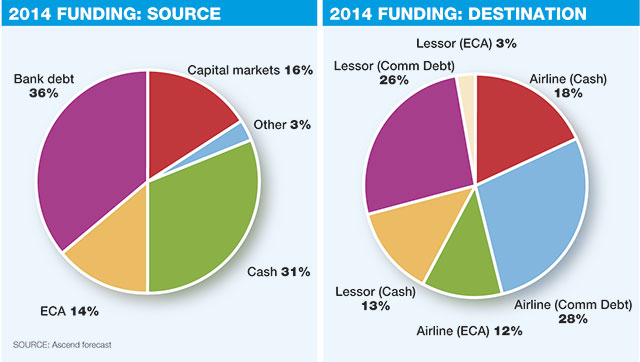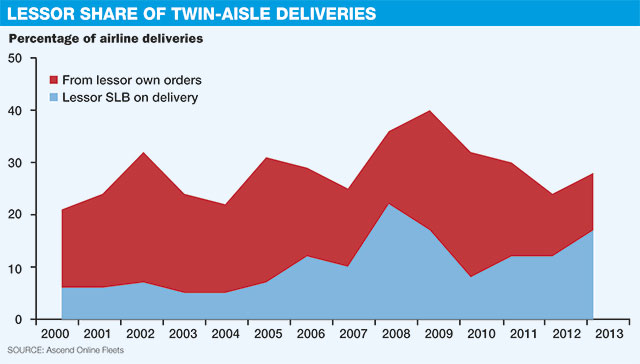Brendan McHenry – senior analyst, risk advisory, with Flightglobal consultancy Ascend – considers how the lessor share is changing in aircraft finance markets
The new year always brings a new financing challenge to the aviation industry. In 2014, there is an estimated $107 billion financing requirement for commercial jet and turboprop aircraft, based on Ascend’s full-life base values. The decrease in export credit agency (ECA) financing is being compensated by capital markets and commercial debt, showing the confidence financiers have about the prospects of asset-backed finance in the aviation sector.
There are clear signs that the industry is firmly on an upward trajectory in the financing cycle. The debt and capital markets are increasing their support to the sector, in parallel with many lessors setting ambitious growth targets, putting their owners’ capital to work. This trend is bolstered by sustained airline industry profitability since 2010, and many participants are regaining confidence in the industry.

A reduction in ECA financing is expected to continue, given the impact of the change in ECA rules. However, airlines that have order backlogs spanning far into the future will be keen to diversify their financing sources, so that when the cycle reverses and if commercial financing sources decline, ECA funding will be more readily available. AirAsia, Lion Air and Norwegian used ECA financing in 2013 along with other methods, and together, they have an average of over 90 aircraft to be delivered annually over the next 12 years.
Levels of ECA financing dropped to under 20% of overall financing in 2013, and Ascend estimates that 2014 will bring a levelling off around 14%. The use of ECA guarantees in conjunction with capital market offerings has been helping ECAs maintain their current share. Capital market products do not require the flexibility that many lessor portfolios need, so ECA inflexibility is not an issue. More airlines see the benefits of accessing the capital markets, but many do not have the stability or credit ratings these markets demand and therefore require ECA support.
Mature airlines that decide not to rely on cash flow for financing new aircraft will have the option to access capital markets. With British Airways, United Airlines and Hawaiian Airlines having already completed financing in 2013 for $2 billion of 2014 deliveries, this source is expected to grow throughout the rest of the year. Unrated carriers such as Philippines Airlines have also shown that with the help of ECA guarantees, they too can obtain bond finance, widening the pool of airlines that will this year seek to take advantage of the upturn in the capital markets.
Lessors such as GECAS and Avolon were successful in arranging bonds during 2013, but innovation in the marketplace has been shown by Bank of China-owned BOC Aviation, which launched a yuan-denominated bond (of $164 million) in 2013, bringing aviation financing to new participants. With the level of deliveries heading towards China and the Shanghai Free Trade Zone, conditions are improving for the promotion of more yuan-based aircraft financing.
The lessor share of the fleet in 2013 remained below 40% – at 37% for jets – and, with it having stayed static for two years, any forecast of it reaching 40% in 2014 would be optimistic. Other attractive financing solutions are expected to limit lessor growth, meaning that lessors may not reach the 50% share target some have set for the industry in the longer term. Single-aisle types represent the largest segment of the market for lessors, one where they reached 44% in 2013, but with twin-aisle types, regional jets and turboprops, the lessors have much smaller shares.
In new deliveries of twin-aisle jets, particularly, there was a drop-off in lessor activity between 2009 and 2012, reversing their engagement during the last decade. Only in 2013 has their share of involvement in deliveries increased again, through a five percentage point rise in sales and leasebacks on delivery to 17%.
Twin-aisle aircraft account for $52 billion of financing demand, so the availability of lessor financing is important, although there are fewer players in this sector.
The deliveries from lessors’ own orders fell from 24% of all deliveries in 2010 to just 11% last year. What is likely to change this trend over the medium term is the maturing of the Boeing 787 programme and the introduction of the Airbus A350, both of which have been received positively by lessors. Currently, the lessors account for 11% and 17% of the A350 and 787 backlog respectively, showing their appetite for these new-generation aircraft. We also expect them to be heavily involved in sale-and-leaseback activity for airline-ordered aircraft.

The current A320 and 737 programmes are both nearing the end of their production runs before the transition to the Neo and Max, and some lessors are adjusting their exposure accordingly. The activity in the sale-and-leaseback market shows a steady decline in lessor activity since 2011, dropping from 41% of deliveries to 31% in 2013. Analysis of the lease period in the Ascend database shows that lease lengths have also been growing on new single-aisles, which helps to manage residual value risk for the lessor. The average lease length in 2008 was 7.4 years, compared with the 2013 average lease length of 11.4 years. By pushing out the lease return, the lessor can reduce the residual value risk associated with these end-of-the-line units.
The new year brings a new financing challenge with all players re-examining their goals, be it fleet management, residual value exposure or the flexibility that comes with each financing option. The rise in availability of debt and capital markets gives more options to airlines and lessors alike, and comes at a time when both parties are trying to manage their fleets and the changeover in production programmes.
Source: Cirium Dashboard



















